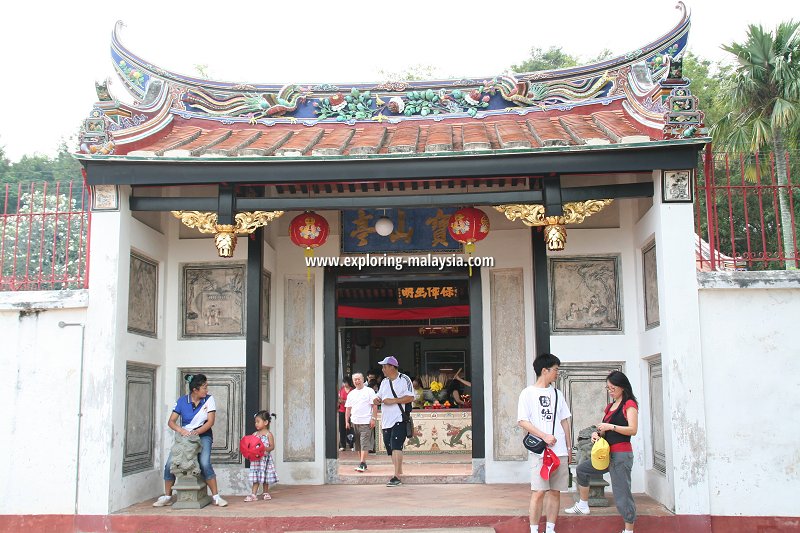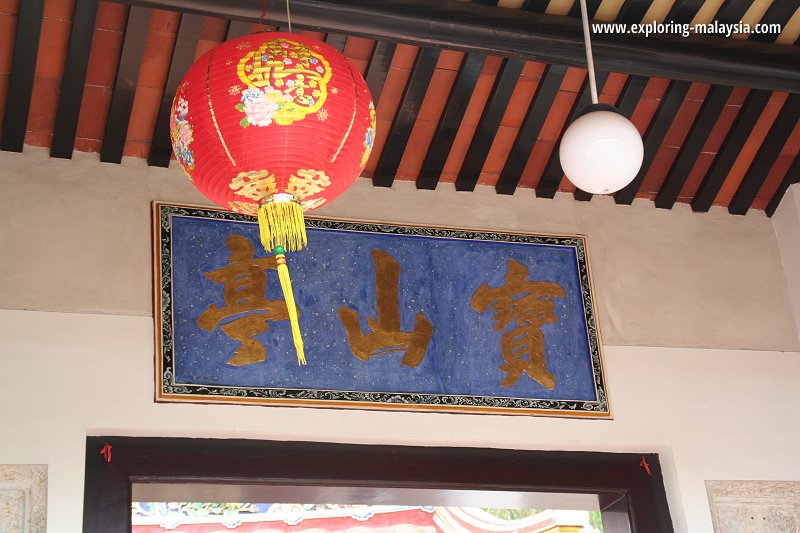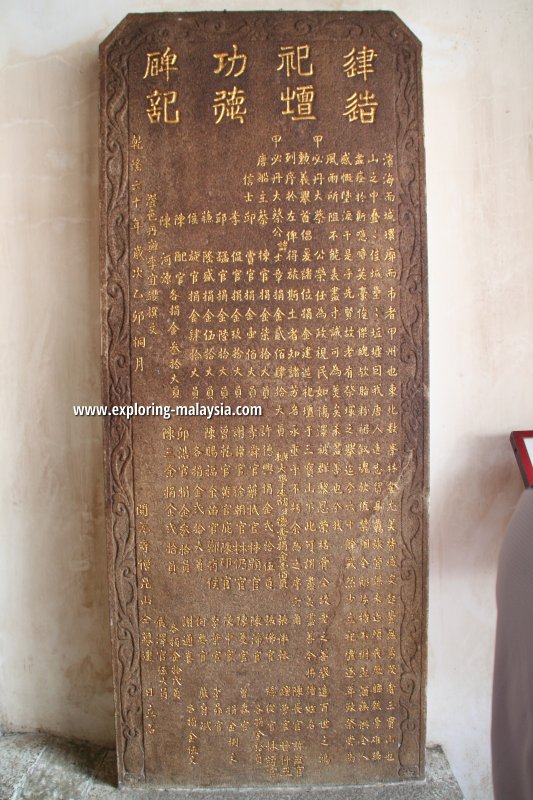 Poh San Teng Temple (2 May 2009)
Poh San Teng Temple (2 May 2009)
Poh San Teng Temple (GPS: 2.196, 102.25541) is the temple at the foot of Bukit China in Malacca. According to local historian Josephine Chua, it was built in 1795 by her ancestor Kapitan Chua Su Cheong, in the same year he was elected Kapitan (leader of the local Chinese community) by the Dutch Government.
An inscription on a stela commemorating the founding of the temple reads: "Bukit Cina is the place where early traders from China were buried. Many Chinese traders came to this country with high expectations of success. Sadly, some died before fulfilling their dreams. Without a family with them, there was no one to pray for their souls. As such, the Chinese Kapitans initiated prayers on their behalf. However, these were always hampered by strong winds and heavy rainfalls because there was no proper shelter. So in 1795, after Chua Su Cheong had been appointed the Chinese Kapitan, he looked into this problem faced by the community and initiated the building of a temple at the foot of Bukit Cina, to ensure that the prayers for those buried in Bukit Cina would not be interrupted."
The name of the temple, Poh San Teng, is inscribed on a 1795 tablet during its founding and is also above the front door of the temple. Moreover, the main deity is "Fu De Zheng Shen" or "Tua Pek Kong". It is the tradition of the Chinese in China as well as Malaysia to dedicate graveyard temples to Tua Pek Kong."
 Poh San Teng Temple (2 May 2009)
Poh San Teng Temple (2 May 2009)
It is often incorrectly assumed that this temple is dedicated to Admiral Cheng Ho (Zheng He), the Ming-dynasty navigator. Many publications therefore erroneously called it the Sam Poh Kong Temple, after the illustrious admiral. In fact, there is no evidence of Zheng He's involvement in the history of the temple. How then did it came to be known by so many as Sam Poh Kong Temple?
The Hill on which Poh San Teng temple was built was written as San Bao Shan on a tablet in the temple. San Bao Shan translates as "Three Gems hill". There is a possibility that the name was shortened to San Bao Temple, and in the ensuing transliteration from Chinese to English confused the meaning.
An image of the deified Admiral Zheng He, known locally as Sam Poh Kong (after the name he acquired while under the service to the Prince of Yan) was added to the Poh San Teng Temple by its caretaker in 1960.2
Within the premises of the temple is the famous well, Perigi Rajah. subject to many legends and stories.
 Founding stelae inside Poh San Teng Temple (2 May 2009)
Founding stelae inside Poh San Teng Temple (2 May 2009)
Poh San Teng Temple is  on the Map of Chinese Temples in Malacca
on the Map of Chinese Temples in Malacca
Poh San Teng Temple is  on the Map of Malacca
on the Map of Malacca
Acknowledgement
1. Thank you to Josephine Chua for her invaluable advise in preparing the information for this webpage.2. Chronology about Bukit China and Poh San Teng (12 October, 2016)
Discover Malacca; list of Chinese Temples in Malacca and Chinese Temples in Malaysia
 Latest updates on Penang Travel Tips
Latest updates on Penang Travel Tips
 Discover with Timothy YouTube Channel
Discover with Timothy YouTube Channel
 PG Food Channel
PG Food Channel
 Learn Penang Hokkien YouTube Channel
Learn Penang Hokkien YouTube Channel
 SojiMart Videos
SojiMart Videos
Latest from Discover with Timothy: Gurney Bay - what to see and do there
About this website

Hello and thanks for reading this page. My name is Timothy and my hobby is in describing places so that I can share the information with the general public. My website has become the go to site for a lot of people including students, teachers, journalists, etc. whenever they seek information on places, particularly those in Malaysia and Singapore. I have been doing this since 5 January 2003, for over twenty years already. You can read about me at Discover Timothy. By now I have compiled information on thousands of places, mostly in Peninsular Malaysia and Singapore, and I continue to add more almost every day. My goal is to describe every street in every town in Malaysia and Singapore.
Robbie's Roadmap
- Episode 1: Robbie's Journey to Financial Freedom
- Episode 2: Lost in America
- Episode 3: The Value of Money
- Episode 4: The Mentor
- Episode 5: The Thing that Makes Money
- Episode 6: The walk with a Billionaire
- Episode 7: The Financial Freedom Awakening
- Episode 8: Meet Mr Washington
- Episode 9: The Pizzeria Incident
Copyright © 2003-2024 Timothy Tye. All Rights Reserved.


 Go Back
Go Back